
Potsdam is the capital and largest city of the German state of Brandenburg. It directly borders the German capital, Berlin, and is part of the Berlin/Brandenburg Metropolitan Region. It is situated on the River Havel some 25 kilometres southwest of Berlin's city centre.

Gebhard Leberecht von Blücher, Fürst von Wahlstatt, Graf (count), later elevated to Fürst von Wahlstatt, was a Prussian Generalfeldmarschall. He earned his greatest recognition after leading his army against Napoleon I at the Battle of the Nations at Leipzig in 1813 and the Battle of Waterloo in 1815.

The Pour le Mérite is an order of merit established in 1740 by King Frederick II of Prussia. The Pour le Mérite was awarded as both a military and civil honour and ranked, along with the Order of the Black Eagle, the Order of the Red Eagle and the House Order of Hohenzollern, among the highest orders of merit in the Kingdom of Prussia. After 1871, when the various German kingdoms, grand duchies, duchies, principalities and Hanseatic city states had come together under Prussian leadership to form the federally structured German Empire, the Prussian honours gradually assumed, at least in public perception, the status of honours of Imperial Germany, even though many honours of the various German states continued to be awarded.

Johann David Ludwig Graf Yorck von Wartenburg was a Prussian Generalfeldmarschall instrumental in the switching of the Kingdom of Prussia from a French alliance to a Russian alliance during the War of the Sixth Coalition. Ludwig van Beethoven's "Yorckscher Marsch" is named in his honor.

August Wilhelm Antonius Graf Neidhardt von Gneisenau was a Prussian field marshal. He was a prominent figure in the reform of the Prussian military and the War of Liberation.

Heino Heinrich Reichsgraf von Flemming was a Saxon, later Brandenburger army leader and Field Marshal and Governor of Berlin.

James Francis Edward Keith was a Scottish soldier and Generalfeldmarschall of the Royal Prussian Army. As a Jacobite he took part in a failed attempt to restore the Stuart Monarchy to Britain. When this failed, he fled to Europe, living in France, and then Spain. He joined the Spanish and eventually the Russian armies and fought in the Anglo-Spanish War and the Russo-Swedish War. In the latter he participated in the conquest of Finland and became its viceroy. Subsequently, he participated in the coup d'état that put Elizabeth of Russia on the throne.

The Victory Column is a monument in Berlin, Germany. Designed by Heinrich Strack after 1864 to commemorate the Prussian victory in the Second Schleswig War, by the time it was inaugurated on 2 September 1873, Prussia had also defeated Austria and its German allies in the Austro-Prussian War (1866) and France in the Franco-Prussian War (1870–71), giving the statue a new purpose. Different from the original plans, these later victories in the unification wars inspired the addition of the bronze sculpture of Victoria, the Roman goddess of victory, 8.3 metres (27 ft) high, designed by Friedrich Drake.

Johann Gottfried Schadow was a German Prussian sculptor.

The Order of the Black Eagle was the highest order of chivalry in the Kingdom of Prussia. The order was founded on 17 January 1701 by Elector Friedrich III of Brandenburg. In his Dutch exile after World War I, deposed Emperor Wilhelm II continued to award the order to his family. He made his second wife, Princess Hermine Reuss of Greiz, a Lady in the Order of the Black Eagle.

Friedrich Drake was a German sculptor, best known for his huge memorial statues.
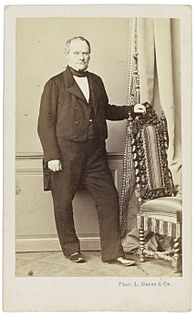
August Karl Eduard Kiss, or Kiß was a German sculptor, known for his monumental bronzes.
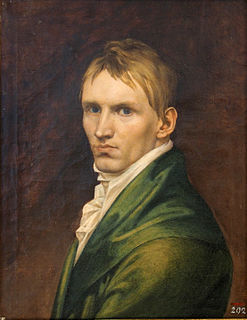
Christian Friedrich Tieck, often known only as Friedrich Tieck, was a German sculptor and a occasional artist in oils. His work was primarily figurative and includes both public statuary and private commissions for portrait busts.
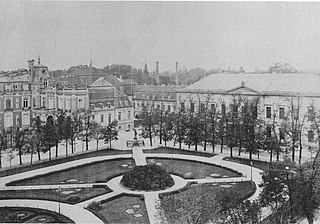
Wilhelmplatz was a square in the Mitte district of Berlin, at the corner of Wilhelmstrasse and Voßstraße. The square also gave its name to a Berlin U-Bahn station which has since been renamed Mohrenstraße. A number of notable buildings were constructed around the square, including the old Reich Chancellery, the building of the Ministry of Finance and the Kaiserhof grand hotel built in 1875.

Moltke Bridge is a bridge over the Spree River in Berlin, Germany. Completed in 1891, it connects Alt-Moabit near the main railway station on the north bank to Willy-Brandt-Straße and the Chancellery on the south bank. The bridge is named after Field Marshal Helmuth von Moltke the Elder (1800–1891), chief of staff of the Prussian Army for thirty years. Moltke died just before the bridge's completion and it was inaugurated by his funeral cortege. The bridge has three crossed arches spanning the Spree made from red Main sandstone, decorated with statues of Johannes Boese, Carl Piper and Carl Begas.
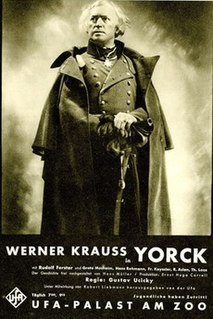
Yorck is a 1931 German war film directed by Gustav Ucicky and starring Werner Krauss, Grete Mosheim and Rudolf Forster. It portrays the life of the Prussian General Ludwig Yorck von Wartenburg, particularly his refusal to serve in Napoleon's army during the French Invasion of Russia in 1812. It was a Prussian film, one of a cycle of films made during the era that focused on Prussian history.
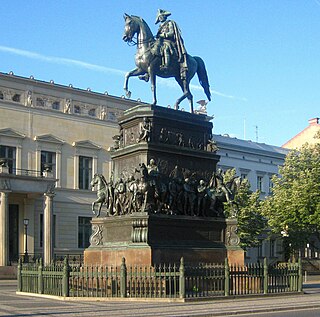
The equestrian statue of Frederick the Great is an outdoor monumental sculpture in cast bronze at the east end of Unter den Linden in Berlin, honouring King Frederick II of Prussia. It was commissioned by Frederick's great nephew, Frederick William III, and dedicated by Frederick's great-great nephew, Frederick William IV. Designed in 1839 by Christian Daniel Rauch and unveiled in 1851, it influenced other monuments. It is a registered monument of the City of Berlin.
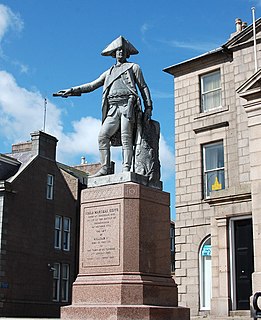
The Statue of Marshal Keith is a Category B listed monument on Broad Street in Peterhead, Scotland, dedicated to James Keith, a Scottish soldier and Generalfeldmarschall of the Royal Prussian Army. The statue, which stands in front of the Peterhead Town House and faces east, was presented by William I, German Emperor. It is a zinc replica of one made of marble that originally stood in Wilhelmplatz, Berlin, but is now in that city's Bode Museum.

The Alexander von Humboldt statue is a monumental statue in Chicago, Illinois, United States. Located in Humboldt Park, a major urban park in the Humboldt Park neighborhood, the statue depicts Alexander von Humboldt, a Prussian polymath and the park's namesake. The statue was dedicated in 1892.
Ferdinand Lepcke (1866–1909) was a German sculptor, who in particular realized two major monuments in Bydgoszcz: the Deluge Fountain and The Archer. He received a golden medal at the Great Berlin Art Exhibition and, the Berlin Minister for Spiritual Education and Medical Affairs awarded him the title of professor.



















